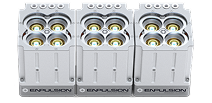Flight Heritage and Status of the Enpulsion Propulsion Systems: Nano, Nano R3/AR3 and Micro R3
Abstract:
Since the first flight of a Field emission electric propulsion (FEEP) thruster in 2018, 190 heritage ENPULSION NANO systems, 18 higher power MICRO systems and 9 novel NANO R3/AR3 systems have been launched. All propulsion systems reported in this work are based on passively fed, Indium based liquid metal FEEP technology that was developed at AIT and later FOTEC, and in which thrust is generated through electrostatic acceleration of ions extracted from a liquid propellant. To achieve this, the liquified metal propellant is suspended in porous, sharp emitter features and biased to high voltage with respect to a counter electrode to induce a Taylor cone on top of the emitter feature. To increase thrust, multiple of these emission sites have been arranged in a characteristic crown shaped emitter geometry for the NANO thrusters, achieving thrust levels in the order of 350 μN. To increase thrust levels, 4 of these emitter crowns are operated in parallel in the MICRO thruster, allowing thrust levels at nominal 1mN. Depending on emitter and extractor voltage settings, propulsion systems can be operated in a specific impulse range from approx. 1000s to beyond 4000s.



